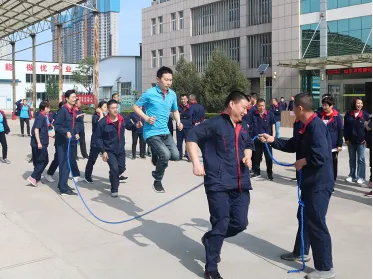Types of rope, and how their properties affect their useage
Polypropylene rope is most commonly used here in the States as "ski rope." It is inexpensive, light weight, strong and it floats. But the polymer structure of polypropylene (and most other polyolefins like polyethylene, etc.) is not resistant to ultraviolet. When exposed to sunlight, it quickly degrades from the ultraviolet radiation. The result is considerable weakening of the rope along with surface oxidation. The loss of tensile strength is naturally a bad thing for a guying application. The surface oxidation is of not much concern here, but when used as an insulator (such as on the ends of a wire dipole), the oxidized surface becomes wettable allowing surface contamination to adhere. This can increase the RF losses of the rope slightly. If you observe polypropylene rope after a season or two outdoors, you can visibly see the surface degradation and you can often seen numerous broken strands.
To slow the degradation of polypropylene rope, or any plastic for that matter, anti-oxidants and ultraviolet inhibitors may be added. These increase the life of the rope somewhat, but they do not offer ever-lasting protection. Certain colors offer better ultraviolet protection too. I am sure that most people are familiar with the fact that organic dyes and pigments fade. Red is probably the worst offender, followed by yellow. Bright white and black generally hold up the best. In polypropylene rope, the black will generally do better than the white. Since the polypropylene is naturally translucent, it takes little white pigment (usually titanium dioxide) to make it white. Black is cheaply obtained by adding carbon black to the polymer melt. The white pigment tends to reflect the ultraviolet while the carbon black tends to absorb it and convert it to heat. With its low pigment loading, black polypropylene is probably better than the white.
A much better choice is nylon rope. It is strong, readily available, and has a fairly high ultraviolet resistance. It does stretch considerably, and this is an important consideration in antenna work. Chemically, the nylons are in a family known as polyamides. Their chemical resistance is normally good except in areas where acid conditions exist. These tend to occur in industrial areas with high smog or where acid rain is prevalent. Again bright white or solid black is to be preferred in outdoor use.
Probably the best rope materials for outdoor use are the polyesters. Typically these are polyethylene terephthalate (PET) or polybutylene terephthalate (PBT), although I suppose polyethylene naphthalate (PEN) ropes exist today. The most common material is PET [more properly called poly(ethylene terephthalate)], known under such trade names as Dacron (DuPont), Fortrel (Wellman), Kodel (Eastman), A.C.E. (Honeywell). etc. [For some reason, rope vendors at many USA hamfests tend to charge a premium for Dacron, probably because of the name recognition.]
Polyester ropes have very low stretch making them excellent for guying applications. They are excellent in both chemical and ultraviolet resistance. The polyester materials have an interesting property that makes them especially ultraviolet resistant. These materials fluoresce upon exposure to ultraviolet light; they absorb ultraviolet radiation and re-emit it as light at a longer wavelength. Generally the emission is in the near-infrared region but some materials fluoresce in the visible spectrum too. This is an effective way of getting rid of the energy absorbed from the ultraviolet and it provides much of the ultraviolet resistance seen in these materials. Their chemical resistance is even better than the nylons. Black or white colors are still to be preferred, although I have seen surplus military rope in the traditional olive-drab color that should perform well. Since the polyesters are generally clear, they take more white pigment to color them than to the polypropylene materials. Thus the white rope is almost as good as black for long-term use.
There are other specialty ropes available such as those made from polyaramides (Kevlar and Nomex by DuPont) and polyimides. The Kevlar ropes are extremely strong, but they require special stranding and covering to avoid abrasion problems; their abrasion resistance is quite poor. There are also composite ropes made with a core of one material which is clad with a woven covering. These tend to be rather specialized and are probably not worth much discussion. However there are polyester covered polypropylene ropes on the market today. These rely on the good strength of the inexpensive polypropylene core, while the jacket provides considerable protection of the core from sunlight. Wire ropes are also commonly available, and entire books have been written on their design and application. It is usually best to consult the manufacturers directly about applications of these specialty ropes.
I hope this gives a better explanation of why you might not want to use polypropylene in many applications. However, I do like to use polypropylene ropes for Field Day antennas. These are used only a few days each year, and the bright colors can provide contrast to prevent people from walking into them! They are inexpensive enough to discard too.
Polyester vs Polypropylene Rope
Rope is available in a variety of materials, EP Launcher International Co,.ltd mainly supply the nylon, cotton, polyester, polypropylene, polyester and rubber material ropes. The type of material used for the rope is the main determinant of the rope’s strength, abrasion resistance, ease of use, and price. For this reason it is important to have a basic understanding of the basic differences between the various rope materials available. Now we mainly to talk about the difference about polyester vs polypropylene rope.
Polyester rope
Polyester rope it’s only about 90% as strong as nylon in strength when a steady force is applied and does not absorb shock loads as well. It is also holds up as well against damage from most chemicals, rot, and mildew as nylon, but is superior in resistance to abrasion and sunlight, stretches far less. What is more, polyester rope Polyester rope is not lose strength when wet as nylon does.
Advantages of Polyester Rope
- Very strong
- Little to no stretch
- Retains strength when wet
- High melting point
- UV resistant
- Excellent abrasion resistance
- Non conductive to electricity
- Good resistance to acids at room temperature. As the temperature increases, the resistance decreases.
- Excellent resistance to petroleum based products, bleaches and solvents. However, this does not mean it is not affected. polyester ropes will weaken if soaked in strong bleach for a long period of time.
Polypropylene rope
Polypropylene rope is the most popular all purpose rope for the average consumer. It is a high quality, light-weight rope that is affordable and very functional. It is high quality, strong for it’s weight, but it is not very UV, heat, or abrasion resistant. For this reason, it is generally not a good choice for long term applications where the rope would be exposed to sun or abrasion. Polypropylene rope is rot resistant and floats, making it very popular for water sports and markers.
Polypropylene is the best choice for budget conscious applications where the rope will not be exposed to abrasion or UV for extended periods of time or where buoyancy is needed. This includes cheap disposable twine, general purpose budget ropes, and infrequently used ropes.
Advantage of Polypropylene Rope
- It floats. That is the single best thing about it! This and the fact that it has some stretch makes it a good water skiing rope.
- It is lightweight and easier to handle in thicker diameters.
- It’s economical compared to other ropes.
- Its quite inert when exposed to chemicals and solvents. It resists acid, bases and solvents well.
- Resists rot and mildew.
Buy polyester vs polypropylene rope, EP Launcher International Co,.ltd is your ideal choice.
Best Rope for Different Weather Conditions
Best Rope for Different Weather Conditions
Sun
Polyester rope is a great rope for climates that receive high amounts of sun exposure due to its resistance to high levels of UV rays and temperatures. It is great for desert climates, locations near the equator, and during the summer months. Polyester rope can withstand intense heat and has a melting temperature between 428-degrees and 500-degrees Fahrenheit.
Rain
Polypropylene rope is resistant to rot, mildew and UV light making it a great rope for rainy days, coastal locations, or tropical climates. It is also a great rope for tying knots and will stay in place without slipping when wet.
Snow
Polyester rope works well in most climates making it a great year-round rope in temperate regions like most of North America, Europe, and northern parts of Asia. It does well in snow due to its ability to hold up to moisture and abrasion. In winter, rope can be used for snow chains, tow rope, and even to remove snow off a roof. Check out the YouTube video from Big World below to see how he kept his home safe from heavy snow.
Humid
Polypropylene rope is a great multi-purpose rope to use in humid areas like coastal and topical locations. The rope is composed of both polypropylene and nylon making it resistant to rot, mold, and mildew which is a great attribute to have in humid climates. It is also easy to take care of in the sun due to its resistance to UV rays and high melting temperature of 320-degrees Fahrenheit or 160-degrees Celsius.
Dry
Polyester rope is great for use in dry desert-like areas like the south-western United States, northern Mexico, northern Africa, central Australia, and Argentina. Polyester has the highest resistance to UV rays of all our ropes and is also abrasion resistant. Both of these factors make it a great rope to have in the desert where it can be sunny and have either very warm or very cold, strong, dry air blowing around the rope.










